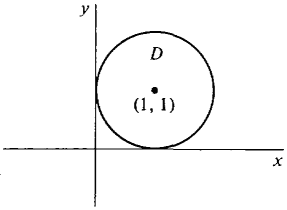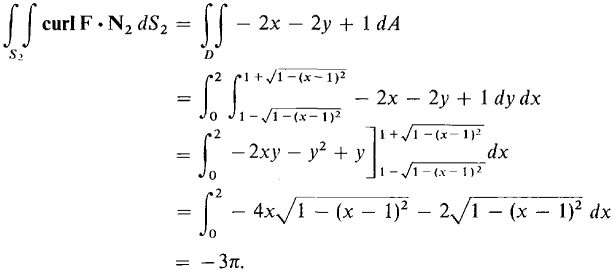| The ebook Elementary Calculus is based on material originally written by H.J. Keisler. For more information please read the copyright pages. |

|

Home  Vector Calculus Vector Calculus  Theorems of Stokes and Gauss Theorems of Stokes and Gauss  Examples Examples  Example 2 Example 2 |
|






|
|
Example 2
EXAMPLE 2 Let S1 be the portion of the plane z = 2x + 2y - 1 and S2 the portion of the paraboloid z = x2 + y2 bounded by the curve where the plane and paraboloid intersect. Orient both surfaces with the top side positive, so they have the same boundary C = ∂S1 = ∂S2. Let F(x, y, z) = zi + xj + yk. Evaluate the integrals (a) (b) (c) By Stokes' Theorem, all three answers are equal, but we compute them separately as a check. The regions are drawn in Figure 13.6.5. First we find the plane region D over which S1 and S2 are defined. The two surfaces intersect at 2x + 2y - 1 = x2 + y2, (x - 1)2 + (y - 1)2 = 1.
Figure 13.6.5 So D is the unit circle with center at (1,1) shown in Figure 13.6.6; that is, 0 ≤ x ≤ 2,
Figure 13.6.6 Next we compute curl F.
(a) On the surface z = 2x + 2y - 1,
Thus
(b) On the surface z = x2 + y2,
Thus
(c) The boundary curve C = ∂Sl = ∂S2 is a space curve on the plane z = 2x + 2v - 1 and over the circle (x - 1)2 + (y - 1)2 = 1. Thus C has the parametric equations x = 1 + cos θ, y = 1 + sin θ, z = 2 cos θ + 2 sin θ + 3, 0 ≤ 0 ≤ 2π. Then dx = -sin θ dθ, dy = cos θ dθ, dz = (-2 sin θ + 2 cos θ)dθ. 
Notice that (a) was much easier than (b) or (c).
|
|
Home  Vector Calculus Vector Calculus  Theorems of Stokes and Gauss Theorems of Stokes and Gauss  Examples Examples  Example 2 Example 2 |
|
Last Update: 2006-11-22












